1 May 2011
Lauren Downes MSPT
In the past year or two, more coaches and professionals have gotten involved in off-ice training with their skaters, in either group or private classes. Many have attained certifications or a degree in a health related field, or studied exercise programs developed by known professionals in the field. Kudos to those coaches who have taken the time to gain the knowledge to further their skaters' progress, and to help them prevent injury.
In the past few months, I have come across a coach conducting classes with skaters that will seriously cause injury to their backs, instructing exercises with extremely forced back hyperextension, no stability holds, and vigorous movements that cause excessive strain on the spine. These talented skaters are seriously risking injury, all due to an instructor who has not researched what she/he is teaching. Seeing this has prompted me to choose the article topic "The Importance of Good Spine Mechanics with Exercise," to give my readers some insight on proper spine mechanics. Hopefully, it can help prevent injuries and teach you what to look for when instructing/ watching instruction of core and flexibility exercises.
1) Your spine is only meant to bend so far!
When you bend forward (flexion) or backward (extension), each spinal segment moves a certain degree on the spinal segment below it. Genetically, you are born with a certain amount of movement in each segment, and you can't increase the joint's mobility with stretching. Stretching targets muscle length, not joint movement. Forcing the spinal joints into extension (extreme or repetitive back bends) will only compress the joints, leading to possible injury. A skater who lacks flexibility in the back should be focusing on flexibility of the muscles that attach at the hip, such the psoas (hip flexor), hamstring, adductor, and piriformis muscles, and not forcing unnatural spine movement.
This principle not only applies to stretching exercises, but strengthening exercises as well. I have witnessed many people over the years completing a hip extension exercise incorrectly, using too much movement in the spine. The picture below shows proper hip extension when all fours.
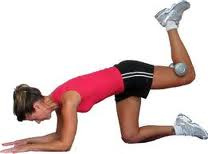
Note that the demonstrator's thigh does not go above the buttocks, and there is no arch in the spine. This is correct technique. Incorrect movement would occur when the back begins to arch, and the thigh lifts past the level of the buttocks. The spine would be forced into extension, and the contraction of the gluts would diminish, defeating the purpose of the exercise.
2) Stability before mobility!
When performing any core stabilization exercises, it is imperative to maintain contraction of the abdominals in what us physical therapists like to call the neutral spine position, with the spine in a straight position (not too arched and not too flat). The abdominals must be able to stabilize the spine in this position, or excessive strain in the spine will occur. I can't tell you how many times I have seen skaters doing exercises WAY above their skill level with an arched back and no abdominal stabilization. Yes, they can complete a very difficult exercise, but if not done in the correct position, the exercise does more harm than good to the spine. Improper movement patterns are continuously reinforced if the skater continues to do the exercise improperly.
When doing any core exercise, a skater should feel like he or she is pulling the belly button towards the spine by tightening the abdominals. This contraction/ position should be held throughout the exercise. If a skater cannot maintain this position, the exercise is too difficult for that skater's skill level. The skater should begin with more basic exercises, and work his or her way up to completing higher level stabilization exercises. Here are some examples of the correct spine position in an exercise:
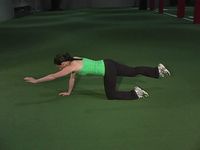 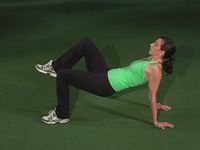 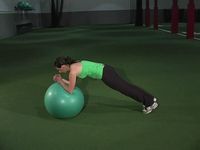
Here are some examples of a common V-sit pilates exercise, with number 1 as correct, and number 2 and 3 as incorrect:
1) 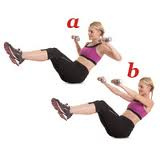 2) 2) 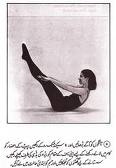 3) 3) 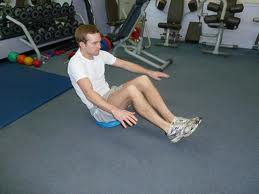
In picture number 1, the demonstrator is able to maintain flat back while balancing on her buttocks. In picture number 2, the demonstrator's lower spine is significantly rounded, with most of the body weight bearing on the lower back. In picture number 3, the demonstrator has a slight rounded position of the lower spine, and also rounded shoulders.
3) Exercise timing is key!
Core exercises that are beneficial to skaters involve a sustained hold of a position with or without movement of the extremities. The abdominals are working to hold a neutral position and resist the spine's ability to change position, just as the abdominals would react to a skater trying to check out of a jump and maintain a stable core. Such examples without extremity movement include a plank (picture 4) or sidebridge (picture 5) exercise.
4) 5) 5) 
An example of a core exercise with extremity movement is in picture 6:
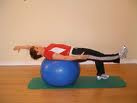
Exercises can be progressed by increasing the amount of hold time per repetition of the exercise. For example, a skater can begin with a twenty second hold in a plank position, and progress to one minute. In the ball exercise, a skater can begin with a three second hold on each side, and progress to a ten second hold.
With all core or stretching exercises, or any exercises for that matter, proper body mechanics is key to improving strength and mobility and to preventing injury occurrence. All professionals should have a proven knowledge of the exercises instructed, and should be able to recognize a skater's capabilities and skill levels. Off-ice training is very important for all skaters to further their skills, but it has to be done in a safe and appropriate manner.
Refer to Sk8Strong's Core Stability Training DVD for beginner to advanced core exercise progressions.
|